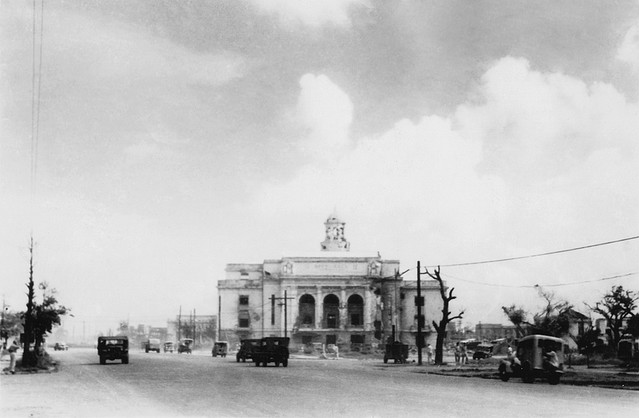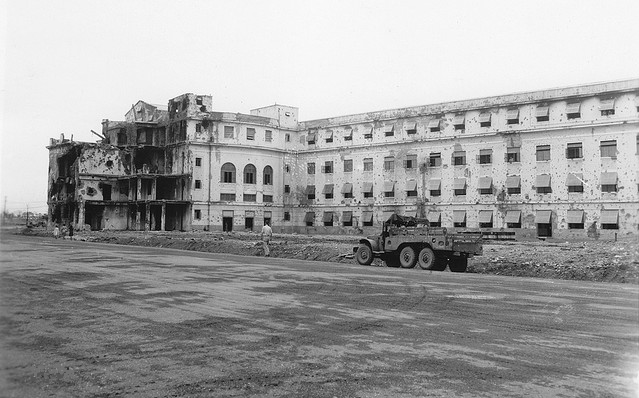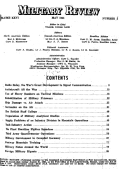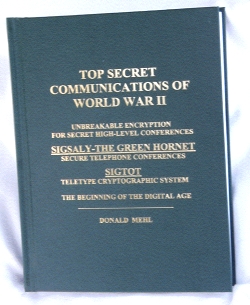Continued from the July 2012 Home Page. To go to an archived version of
that page, click here:
July
2012 Home Page Archive. To return to this
month's actual Home Page, click on the Signal Corps
orange Home Page menu item in
the upper left corner of this page.

continuing...
The chief of the Army Communications System,
General Frank Stoner,
ordered that all of the army stations around the world try
to break in on one of the Japanese stations. He said that it
was the greatest concentration of radio power ever focused
on one station. Stations world-wide were calling. Finally,
near midnight, the Japanese station, JUM, while working
Singapore heard the U. S. radio station and asked the
Singapore station to stand-by so he could listen to WTA
Manila.
WTA was swamped with calls from stations all over the
Pacific telling WTA that the Japanese station JUM was
answering. WTA sent the MacArthur messages and received a
receipt at 00:25 A. M. on August 16, 1945.
 Another
Japanese radio operator at Japanese station JNP called WTA
and asked, “Do you want an answer to your message?” The
American officer-in-charge sent a very emphatic and
resounding "YES" to the Japanese station. The channel to the
Japanese Imperial Headquarters was set up. The planning for
the surrender arrangements went on for three days. This was
the surrender on the air.
Another
Japanese radio operator at Japanese station JNP called WTA
and asked, “Do you want an answer to your message?” The
American officer-in-charge sent a very emphatic and
resounding "YES" to the Japanese station. The channel to the
Japanese Imperial Headquarters was set up. The planning for
the surrender arrangements went on for three days. This was
the surrender on the air.
The final formal message to the Imperial Command was a long
document that listed in detail all of the prisoner of war
locations and troop locations and how they should be turned
over to Allied authorities. It was good that the Emperor had
ordered this since in general most of the forces complied.
The envoys from the Emperor were ordered to come to Manila
for the surrender conference. The message detailed that they
should fly in an airplane painted white without markings and
they should fly a certain route. This was in order that they
would not be accidentally shot down.
The Japanese representatives flew to Manila, landed at
Nichols Field, and met with General MacArthur and his staff
in the air-conditioned conference room of the 805th Signal
Service Company at the City Hall that was the headquarters
of General MacArthur and his staff. The room was
air-conditioned, of course, because air-conditioning was
required for the operation of the SIGSALY terminal
equipment. This was most likely the only air-conditioned
conference room in the devastated city of Manila at that
time. History does not record this as being the location of
the initial surrender conferences because the existence and
location of the SIGSALY system was restricted information
and authors did not have this information. They assumed that
the meetings took place at the Manila Hotel where General
MacArthur had his living quarters. This was not true. I
verified this information in 1945 at Manila with the 805th
officers who were present at the time. It was logical that
the meetings would have been held at MacArthur’s
headquarters where his staff was located and in the
air-conditioned conference room of SIGSALY where immediate
access by secret telephone or teletype was available to the
Pentagon or White House. The culmination of the surrender on
the air, conference, and agreements made in the SIGSALY
conference room of Detachment 4 of the 805th Signal Service
Company resulted in the formal surrender signing on the
battleship Missouri on September 2, 1945.
- - - - - -
City Hall, where the 805th maintained SIGSALY conference room was located.
This view shows the entrance that MacArthur used when he entered the
building.

Moving around the corner to the right, this is the view that was seen. It
hardly looks like the same building.

 Editor's Note: Many stories have been written of the final surrender of
Japan to the US. The story written here is an original composition by Donald
E. Mehl,
Army Signal OCS Class 44-35, written for ArmySignalOCS.com. His story is based on his personal experiences and research.
Don served with the 805th, the unit that assembled and maintained the Top Secret
communication equipment and facilities used in the surrender and was
responsible for the facilities during that period. One of the earliest
retellings of this story was produced by the Signal Corps itself in a 1946
publication. To tie the stories together and do homage to the original we
have reused the title from that article for Don's article here: Surrender
On The Air. Interested readers can download and read the original May
1946 article by clicking on the icon at right.
Editor's Note: Many stories have been written of the final surrender of
Japan to the US. The story written here is an original composition by Donald
E. Mehl,
Army Signal OCS Class 44-35, written for ArmySignalOCS.com. His story is based on his personal experiences and research.
Don served with the 805th, the unit that assembled and maintained the Top Secret
communication equipment and facilities used in the surrender and was
responsible for the facilities during that period. One of the earliest
retellings of this story was produced by the Signal Corps itself in a 1946
publication. To tie the stories together and do homage to the original we
have reused the title from that article for Don's article here: Surrender
On The Air. Interested readers can download and read the original May
1946 article by clicking on the icon at right.
 The
full story
on the Top Secret SIGSALY and SIGTOT communication systems, including
background information on the Japanese surrender, its use in Europe, and
much more can be found in a book Don published called Top Secret
Communications of World War II. The book is available on our PX page.
Click the icon at right to get your copy.
The
full story
on the Top Secret SIGSALY and SIGTOT communication systems, including
background information on the Japanese surrender, its use in Europe, and
much more can be found in a book Don published called Top Secret
Communications of World War II. The book is available on our PX page.
Click the icon at right to get your copy.

